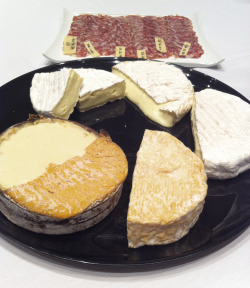


Exploring Cheese & Microbes at ACS 2014
One of the most interesting sessions of last week's #CheeseSociety14: Cheese, Salame & Microbes—Parallels and Discoveries, with Paul Bertolli of Fra'Mani Handcrafted Foods, Dr. Ben Wolfe of Harvard University (soon to be at Tufts University, and the other half of the groundbreaking cheese microbiome detective team with Dr. Rachel Dutton), and Mateo Kehler of The Cellars at Jasper Hill. Bertolli brought the salami, Kehler brought the cheese, and Wolfe brought the deep knowledge of microbial communities — in both wheels and sausages — to explore the parallels, and differences, between cheesemaking and the fabrication of salumi.
In many ways the processes are quite similar: both rely on the removal of moisture, the raising and lowering of pH during aging, the feeding of lactobacilli on sugars (naturally occurring Lactose in the case of milk, adjunct Dextrose in the case of many Salames), and the encouragement of a host of natural and added bacteria, yeasts and molds to do their work and transform a starting product, whether milk or meat, into a vast spectrum of flavor and aroma profiles.
Bertolli had brought 6 different salami’s, each innoculated with a different blend of starter or surface cultures. Kehler had brought 4 different wheels of the soft-ripened, bloomy rind Moses Sleeper, each made with slightly different cultures, or different target moisture levels, sometimes from the same batch but with different ripening processes, producing starkly different results and variations in texture, flavor, and rind appearance. There was also a wheel of the Winnimere — last year’s ACS Best in Show winner — a good example of microbial management at its best.
Many of the bacterias, yeasts and molds used between the two processes are of the same species’, often identical or slightly different strains. If you’ve ever had a link of salami that had a white fuzz on the outside, it’s not a coincidence that it resembles a bloomy rind cheese like Camembert. A sausage with a sticky color and no white indicates that yeasts rather than molds have dominated the ripening process, and one can see a similar difference in cheeses, where yeasty cheeses tend to have a more pillowy, fragile rind that can be on the moist side.
Dr Wolfe provided a rich overview of the microbial processes at work in salume and cheese. As he told us, microbial biodiversity can be lower in salume than cheeses, although they’re still not sure why, and the sausage casing can bring its own cultures to the mix. Every bite of cheese or salume is loaded with live cultures (ten to the tenth roughly, in fact). He even brought petri dishes so that we could observe the different cultures in their isolated states.
Kehler finished the session with an introduction to the new labs that the Cellars at Jasper Hill have recently created, to explore the microbial universe of cheese and create a resource for cheesemakers to identify, isolate and eventually reuse the natural cultures occurring in their milks; or as Mateo put it: “Farmer Brown’s milk sequenced, isolated and given back for them to use”.
The Cellars have recently hired a full-time microbiologist to work on site, someone who had previously worked at White Labs, one of the top resources for the craft beer industry — beer being another key environment in the emerging awareness of microbial foods.
Dr Wolfe has now partnered with Bronwen Percival of Neil’s Yard Dairy on a website, MicrobialFoods.org, which is well worth a read if the subject interests you.
Recent comments
Blog comments powered by DisqusNotes
emptyrefrigerators reblogged this from cheesenotes
frankiefreefall liked this
 sogwop liked this
sogwop liked this onetraveleramongsttravelers-blog liked this
malcarons reblogged this from cheesenotes
elimar525 liked this
yeskentuckycheeseguild reblogged this from cheesenotes
katzingers liked this
pactehne-blog liked this
corxandforx liked this
itsme-myeouz liked this
cheesedeity liked this
jessiequab liked this
sandwitchnsaltydogs liked this
babyminotaur liked this
longlivetheloud liked this
freelancenobody liked this
alwayscheesecake liked this
creditskeeprolling liked this
missminifer liked this
 deol84 liked this
deol84 liked this  bean-cheese-burra liked this
bean-cheese-burra liked this danfuckedoffbutreturns reblogged this from cheesenotes
tianisacolor24 liked this
danteo liked this
fanghook liked this
princessshayles liked this
3asybak3d liked this
benjamin-bollens liked this
cheesenotes posted this









